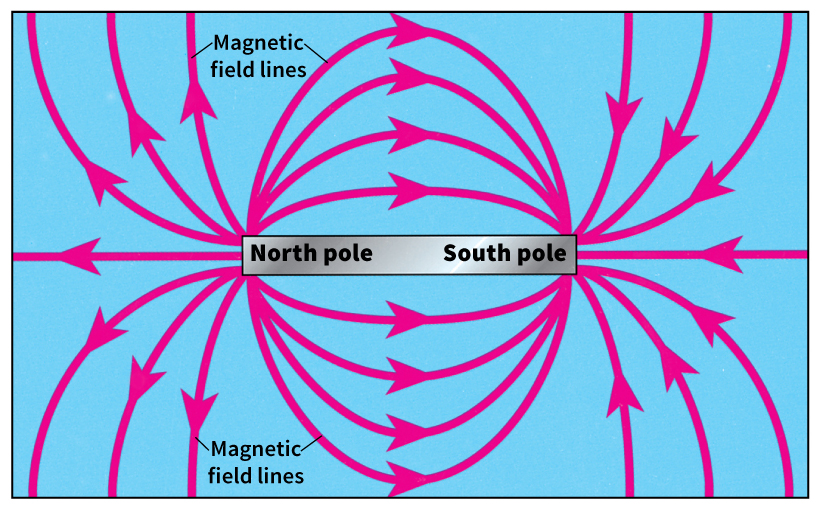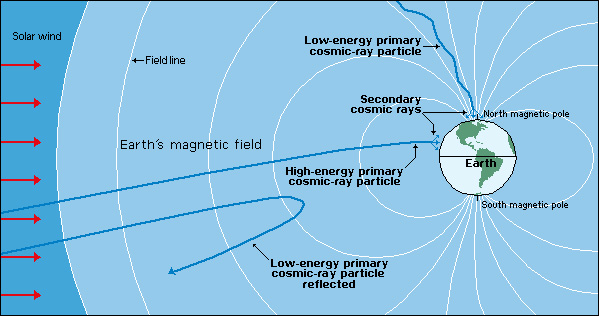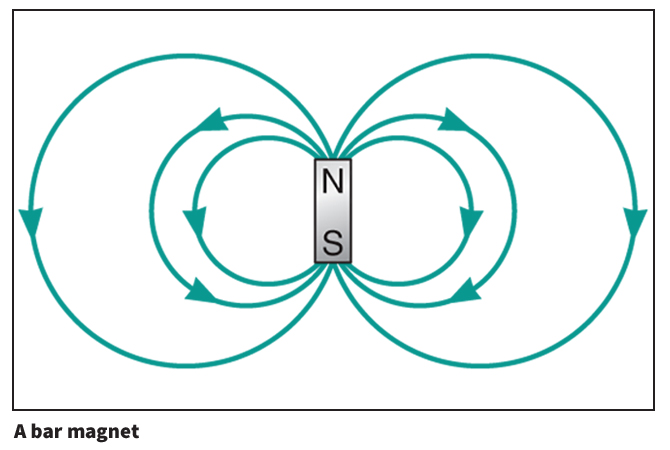Cosmic rays are electrically charged, high-energy particles that travel through space. They are subatomic particles, units of matter smaller than an atom. Astronomers think that cosmic rays fill galaxies, including our own Milky Way, and cross vast stretches of intergalactic space (the space that separates the galaxies).
Scientists study cosmic rays because these particles include the only matter that reaches Earth from outside the solar system. Studies of cosmic rays reveal conditions in intergalactic space and interstellar space (the space that separates the stars). Scientists also study cosmic rays to learn about supernovae (exploding stars).
Physicists measure the energy of cosmic rays in units called electronvolts (eV). One electronvolt is the energy needed to move an electron between two points with a potential difference of 1 volt (see Volt). Most cosmic rays have energies between a few million and a few billion electronvolts. Scientists abbreviate 1 million electronvolts as 1 MeV and 1 billion electronvolts as 1 GeV. A proton with 1 GeV of energy can go through almost 2 feet (60 centimeters) of iron. The highest-energy cosmic rays reach 100 billion GeV. They can have well above 10 million times the energy of the most energetic particles scientists can produce using devices called particle accelerators.
Loading the player...Proton cosmic rays
Scientists divide cosmic rays into two types: (1) primary cosmic rays, or primaries, which originate in outer space; and (2) secondary cosmic rays, or secondaries, which originate in Earth’s atmosphere. Secondaries form when primaries collide with atoms at the top of the atmosphere. The collision changes the primary and the atom into a shower of secondaries. Many secondaries then collide with other atoms, making more secondaries. Some secondaries reach the surface and even penetrate deep into the ground. No measurable amount of primaries reaches Earth’s surface.
Primary cosmic rays
Primary cosmic rays move through space at almost the speed of light, which is 186,282 miles (299,792 kilometers) per second. Most primaries that reach Earth’s atmosphere have traveled through the Milky Way for millions of years.
The travel of primary cosmic rays
is controlled by magnetic fields. A magnetic field is a region where magnetic forces can be felt. It can be thought of as a set of imaginary lines extending through space. None of these field lines crosses another. In outer space, where magnetic fields are weak, a field line may stretch trillions of miles from its source. It is often not clear where these fields originate. If a cosmic ray crosses a field line, the field bends the ray’s path at a right angle to its original path. Cosmic rays therefore can move easily along magnetic fields but have difficulty traveling far across them.

Primaries travel randomly along magnetic fields for an average of 10 million to 20 million years. Because this motion is random, the direction from which a primary arrives gives scientists no indication of its source.
Some cosmic rays eventually leave the galaxy. Others strike so much interstellar matter that they lose almost all their speed and become particles of interstellar matter themselves.
Kinds of primaries.
Scientists have identified four kinds of primary cosmic rays. They are: (1) galactic, (2) ultra-high-energy, (3) solar, and (4) anomalous component.

Galactic cosmic rays
come from outside the solar system. Most primaries are galactic cosmic rays. About 98 percent of galactic cosmic rays are atomic nuclei, which have a positive charge. Single protons—nuclei of hydrogen atoms—account for about 87 percent of these nuclei. Roughly 12 percent are helium nuclei, consisting of two protons and two neutrons. Nuclei of all chemical elements heavier than helium make up the remainder. The 2 percent of galactic cosmic rays that are not nuclei consists of electrons, which are negatively charged, and positrons. A positron has the same mass (amount of matter) as an electron but carries a positive charge.
Scientists think that galactic cosmic rays get their energy from shock waves produced by supernovae or from strong magnetic fields around neutron stars. A neutron star is an extremely dense, rapidly rotating star that remains after some supernova explosions. Galactic primaries may also gain energy from weaker waves that travel along the weak magnetic fields of interstellar space.
A magnetic field carried by the solar wind prevents some galactic cosmic rays from entering the solar system. The solar wind is a continuous stream of high-speed ions (electrically charged particles) and electrons flowing from the sun. These particles have too little energy—only about 1,000 eV—to be cosmic rays.
Activity on the sun’s surface disturbs the solar wind. Solar activity increases and decreases in an 11-year cycle called the sunspot cycle. As activity increases, the flow of the solar wind becomes more disturbed, and the magnetic field becomes more complicated. As a result, primaries have more difficulty reaching Earth. Over the sunspot cycle, the number of galactic primaries striking each square inch (6 square centimeters) of the top of the atmosphere varies from two to six per second.

Ultra-high-energy cosmic rays
also come from outside our solar system. However, they have much more energy than galactic cosmic rays do. They are the most energetic rays in all of nature. Ultra-high-energy cosmic rays rarely reach Earth, striking any given square mile (2.6 square kilometers) of the atmosphere only about once a century. This fact makes them difficult to detect. When they do strike, however, they can produce a shower of low-energy secondaries covering tens of square miles or kilometers.
Scientists do not know exactly where ultra-high-energy cosmic rays come from or what gives them their energy. Supernova shock waves rank as the most powerful known source of energy in our galaxy, but ultra-high-energy cosmic rays have more energy than even a supernova can provide. In 2017, scientists confirmed that these particles come from outside our galaxy. For this reason, they are sometimes called extragalactic cosmic rays.
The more energy a particle has, the less its movement is changed by magnetic fields. Thus, scientists hope to learn about the source of ultra-high-energy cosmic rays by determining the direction from which the rays arrive.
Solar cosmic rays,
also called solar energetic particles, are produced by the sun during solar flares and other spectacular eruptions on the sun’s surface. Solar flares occur mainly during periods of high activity in the sunspot cycle. Most solar cosmic rays consist of protons with energies of only a few MeV. However, large flares can produce particles with energies up to a few GeV. Solar cosmic rays also include some heavier nuclei and electrons.
Anomalous component cosmic rays
develop from normal atoms in interstellar gas near the sun. Because they have no electric charge, the atoms pass freely through the solar wind and its magnetic field. Close to the sun, some atoms absorb so much energy from the sun’s ultraviolet radiation that they lose an electron. Each atom that loses an electron becomes a positive ion. Almost all ions produced in this manner are ions of hydrogen, helium, nitrogen, oxygen, and neon.
The solar wind picks up the new ions and carries them to the edge of the heliosphere, the huge region of space filled by the solar wind. There, something accelerates the ions to energies of up to hundreds of MeV. A shock wave might provide the necessary acceleration. One such wave, called the termination shock, occurs where the solar wind runs into interstellar material and slows down.
After they are accelerated, the ions can reenter the heliosphere as anomalous component cosmic rays. During low points in the sunspot cycle, there are more anomalous component primaries than galactic primaries in the heliosphere at energies below about 100 MeV.
Anomalous component primaries are too weak to produce many secondaries. Scientists therefore did not discover them until the early 1970’s, when spacecraft carried instruments that could detect them. The scientists called them anomalous component, meaning peculiar part of a group, because they differed greatly from galactic and solar primaries.
Secondary cosmic rays
Secondary cosmic rays include all types of subatomic particles. Most secondaries are muons, which are similar to electrons but more massive. Physicists discovered many types of subatomic particles in secondaries before they could produce them in particle accelerators.
Secondaries slow down in the atmosphere. Only a small fraction of them reach Earth. Every minute, about six secondaries strike each square inch of Earth. Because Earth’s magnetic field deflects (turns aside) many cosmic rays, fewer secondaries strike near the equator than strike near the poles.
Effects of cosmic rays
Cosmic rays do not produce enough radiation on Earth to harm living things. Above the atmosphere, however, the radiation reaches harmful levels. It becomes extremely dangerous in the Van Allen belts, regions that contain large numbers of particles. The radiation can also reach extremely dangerous levels anywhere above the atmosphere during solar flares.
Galactic primaries consisting of heavy nuclei have caused problems in electronic circuits that are on spacecraft. If a heavy nucleus hits an ordinary computer chip, the chip may stop operating properly. As a result, engineers have developed chips that are less sensitive to cosmic rays.
Cosmic rays also produce radiocarbon in the atmosphere. Radiocarbon, or carbon 14, is a radioactive form of carbon. Scientists can use it to determine the age of ancient materials and to study solar activity.
Cosmic ray research
During the late 1800’s, physicists used electroscopes to study radioactivity. An electroscope stores electric charge and indicates the presence of the charge. Exposure to high-energy radiation causes a charged electroscope to lose its charge. Even when the electroscopes were shielded from the most powerful rays known to be given off by radioactive substances, they showed that radiation was still present.
In a series of experiments conducted from 1911 to 1913, the Austrian physicist Victor F. Hess took electroscopes up in a balloon, sometimes reaching heights of more than 16,000 feet (5,000 meters). He showed that the mysterious radiation increased with altitude. Hess concluded that the radiation must originate in the upper atmosphere or beyond. In 1936, he received the Nobel Prize in physics for discovering cosmic rays.
By the late 1950’s, scientists had used many types of instruments on the ground and in balloons to determine that cosmic rays are electrically charged particles and that they consist mostly of hydrogen and helium nuclei. Researchers had also discovered that solar activity affects the intensity of cosmic rays.
Since the 1960’s, scientists have used balloons and spacecraft to study low- and medium-energy primaries. They have used large instruments on the ground to study secondaries. Space probes beyond the outer planets continue to provide information on how the heliosphere affects cosmic rays.
During the 1990’s, the observation of particle showers produced by ultra-high-energy cosmic rays led physicists to begin building the Pierre Auger Observatory. The observatory is named for Pierre V. Auger, a French physicist who studied cosmic rays throughout the 1900’s. It consists of a network of particle detectors spread across about 1,200 square miles (3,000 square kilometers) of the Pampas, a vast plain in Argentina. It was designed to observe a large sample of particle showers from ultra-high-energy cosmic rays in an attempt to determine the rays’ origin.
In 2011, the Alpha Magnetic Spectrometer (AMS) began operation aboard the International Space Station. The AMS is more advanced than previous detectors of primaries.
In 2013, scientists announced the first direct evidence that at least some galactic cosmic rays originate within the remnants of supernovae. The evidence was gathered using both Earth-based telescopes and space telescopes.
